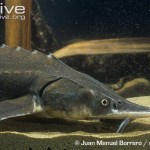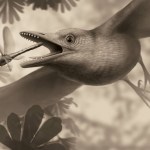fossil
Greg Laden reports on a hominid fossil "recovered from the seabed near Taiwan" which reveals new levels of dental diversity among proto-humans and may qualify as a new species. Greg says the specimen known as Penghu "is yet another indicator that multiple different hominids lived on the Earth at the same time after the rise of Homo erectus." But why was it located underwater? In another example of what lies beneath, Dr. Dolittle marvels at "an unexpected find and very exciting moment for researchers;" the discovery of small fish and invertebrates thriving below 740 meters of ice near the…
Siberian sturgeon in captivity
Drs. Thomas Eliot Haworth and Holly Shiels (University of Manchester) teamed up with Drs. Jaakko Haverinen and Matti Vornanen (University of Eastern Finland) to explore how electrical signaling in the hearts of fish have evolved by comparing Teleost fish with sturgeons. Their findings were published this month in the American Journal of Physiology - Regulatory, Integrative and Comparative Physiology.
According to the study authors, there are currently approximately 27,000 species of ray-finned fishes which make up 99% of all fishes existing today. Teleost…
Image Credit: Stephanie Abramowicz
Image Credit: Stephanie Abramowicz
Researchers have unearthed a fossil of a robin-sized bird (Sulcavis geeorum) from the Cretaceous Period in China that had teeth! This species belonged to a class of birds with teeth (Enantiornithines) that were plentiful in the age of the dinosaurs. However, the teeth of this well-preserved specimen were different. The teeth were sharp and had serrated ridges. The researchers think the ridges observed on the teeth were designed to crack open insects with hard shells, snails or perhaps even crabs. What I also found…
The skeletons of Lucy (left) and Kadanuumuu (right). Both belong to the early human species Australopithecus afarensis. (Images not to scale.)
I never fully appreciated how small Lucy was until I saw her bones for myself. Photographs and restorations of her and her kin within the species Australopithecus afarensis had never really given me a proper sense of scale, and when I looked over her incomplete skeleton - formally known as specimen A.L. 288-1 - I was struck by her diminutive proportions. In life she would have only been about three and a half feet tall. Her physical stature seemed…
A few weeks ago I started prep work on a Tyrannosaurus rex toe bone recovered from Montana's Hell Creek Formation and kept at the New Jersey State Museum. This is how the gypsum-encrusted bone looked when I started...
... and this is how it looked at the end of last week. There's still a lot of work to do, but it is encouraging when you start seeing more bone than gypsum.
A golden-mantled ground squirrel (Spermophilus lateralis), photographed in Bryce Canyon National Park, Utah. Though abundant at the Samwell Cave Popcorn Dome, California site during the Late Pleistocene, its numbers in the area decline at the beginning of the present Holocene epoch.
"One of the penalties of an ecological education", the naturalist Aldo Leopold once wrote, "is that one lives alone in a world of wounds." Few knew this better than he did. Despite becoming a celebrated advocate of wilderness for its own sake during the early twentieth century, Leopold began his career by…
"Dinah", a young female gorilla kept at the Bronx Zoo in 1914. From the Zoological Society Bulletin.
Frustrated by the failure of gorillas to thrive in captivity, in 1914 the Bronx Zoo's director William Hornaday lamented "There is not the slightest reason to hope that an adult gorilla, either male or female, ever will be seen living in a zoological park or garden." Whereas wild adult gorillas were "savage" and "implacable" beasts which could not be captured (a photo of a sculpture included in Hornaday's article depicts a gorilla strangling one man, brandishing another about with its other…
The skull of Paranthropus boisei ("Zinj," "Dear Boy," "Nutcracker Man," etc.).
Louis Leakey had a problem.
During the summer of 1959 he and his wife Mary recovered the skull fragments of an early human scattered about the fossil deposits of Olduvai Gorge in Tanzania. The skull had been deposited among the shattered bones of fossil mammals and a collection stone tools, and this led Louis to conclude that it was one of our early ancestors. Only an ancestor of Homo sapiens could be a toolmaker, Louis thought, but the skull looked nothing like that of our species.
When Mary fit all the pieces…
The skull of Nyctereutes lockwoodi as seen from the side and above. From Geraads et al, 2010.
In 2006 paleoanthropologists working in Ethiopia made a spectacular announcement - they had found the well-preserved remains of a juvenile Australopithecus afarensis, one of our prehistoric hominin relatives. Quickly dubbed "Lucy's baby" this 3.4 million year old specimen graced the cover of Nature and numerous news reports, yet its description represents only a fraction of the paleontological work being done in the area. Many other fossil animals have been found along the banks of the Awash, too…
The skeleton of Palaeobatrachus from Lake Enspel, Germany. From Wuttke and Poschmann, 2010.
In On the Origin of Species, Charles Darwin said of the fossil record:
For my part, following out Lyell's metaphor, I look at the natural geological record, as a history of the world imperfectly kept, and written in a changing dialect; of this history we possess the last volume alone, relating only to two or three countries. Of this volume, only here and there a short chapter has been preserved; and of each page, only here and there a few lines. Each word of the slowly-changing language, in which…
Close up of one of the Pipe Creek Sinkhole coprolites showing structures interpreted as hair (A) and a close-up of a mold in the coprolite thought to have been made by a hair (B). From Farlow et al, 2010.
Time and again I have stressed that every fossil bone tells a story, and, in a different way, so do coprolites. They are small snapshots of a moment in the life of an organism, often preserving bits of their meals, and while they may not get top billing in museum halls, they are among the most pungent reminders that weird and wonderful organisms really did live during the remote past. As…
Mammal hairs preserved in amber specimen ARC2-A1-3. a - First fragment; b - Line drawing of first fragment; c - Second fragment; d - Line drawing of second fragment; e - Close-up of second fragment to show the cuticular surface.
About 100 million years ago, in a coastal forest located in what is today southwestern France, a small mammal skittered up the trunk of a conifer tree. As it did so it lost a few of its hairs, and this minor event would have been entirely unremarkable if two of those hairs had not settled in some tree sap and, in the course of time, become entombed in a piece of…
A restoration of Megatherium from H.N. Hutchinson's Extinct Monsters.
For over a century and a half dinosaurs have been the unofficial symbols and ambassadors of paleontology, but this was not always so. It was fossil mammals, not dinosaurs, which enthralled the public during the turn of the 19th century, and arguably the most famous was the enormous ground sloth Megatherium. It was more than just a natural curiosity. The bones of the "great beast" represented a world which flourished and disappeared in the not-so-distant past, but, as illustrated by Christine Argot in a review of its…
Components of the newly-described Fezouata fauna. a, Demosponge Pirania auraeum b, Choiid demosponge c, Annelid worm d, Organism showing possible similarities to halkieriids e, Possible armoured lobopod f, Thelxiope-like arthropod g, Marrellomorph arthropod, probably belonging to the genus Furca h, Skaniid arthropod i, Spinose arthropod appendage
apparatus consisting of six overlapping elements. From Van Roy et al, 2010.
When the Cambrian period comes up in conversation, it is usually in reference to the evolutionary "explosion" which occurred around 530 million years ago. Animal fossils…
In the Fayum desert of northern Egypt, not too far from the banks of the Nile, the vestiges of ancient forests are preserved in the sand-covered strata. The fossils are ghosts of a vanished oasis in which prehistoric cousins of modern elephants wallowed in lush wetlands and a host of ancient primates scrambled through the trees, and despite being known as one of the world's best fossil sites for over a century paleontologists are continuing to discovery new species from the desert rock. The trouble is that not all these new species are easily classified.
Approximately 37 million years ago,…
The jaws of C. megalodon as restored by Bashford Dean for the AMNH in 1909. Image from the American Museum Journal.
My early elementary reading school choices often got me into trouble. Every week I would pass over the recommended, grade-appropriate sections for the few shelves containing the books about dinosaurs, sharks, and alligators - if it was big and hard sharp teeth, I wanted to learn about it. The school librarian was not too pleased with this, even calling my parents in on one occasion to insist that I read something fit for younger children, but I just could not get enough of…
The skeleton of Megatherium, as figured in William Buckland's Geology and Mineralogy Considered With Reference to Natural Theology.
There is something fantastically weird about giant ground sloths. Creatures from a not-too-distant past, close enough in time that their hair and hide is sometimes found in circumstances of exceptional preservation, these creatures have no living equivalent. Their arboreal cousins still live in the tropics of the western hemisphere, but they can hardly be considered proxies for the ground sloths of the Pleistocene.
The most famous of these ancient beasts was…
One of the fossil fish I found in the Green River Formation of Wyoming.
I had my doubts about whether we were going to reach the quarry. The Toyota Yaris my wife and I had rented for our excursion through Utah and Wyoming was not designed to handle the rough dirt roads which wound their way through the grassy hills of the Equality State, but eventually the outcrop of grey-and-yellow rocks came into view. It was part of the famous Green River Formation, an approximately 42-53 million year old slice of earth's history known to be rich in fish fossils.
It did not take long to start finding…
The skeletons of female (larger, background) and male (smaller, foreground) Dinornis robustus, with a pigeon skeleton for comparison. From Allentoft et al 2010.
A little more than 700 years ago, multiple species of the gigantic, flightless birds called moas were still running around New Zealand. They ranged over almost the entirety of the North and South Islands, from the coast to the mountain forests, but when the Maori people arrived in the late 13th century the birds were quickly driven to extinction. Within a few hundred years they were entirely wiped out (along with the immense Haast…
I feel like I have been run over by a truck. Between blogging, working on my book, fieldwork, pitching freelance articles, and research, I just didn't have the energy to come up with something new today. Instead enjoy this post, written a little more than a year ago, about how the hip of a fossil whale was mistaken for the shoulders of an ancient bird. -- Brian
The right hip of Basilosaurus as seen in Lucas' 1900 description.
If you were a 19th century paleontologist and you wanted a skeleton of the fossil whale Basilosaurus, there was only one place to look; Alabama. Even though fossils…

